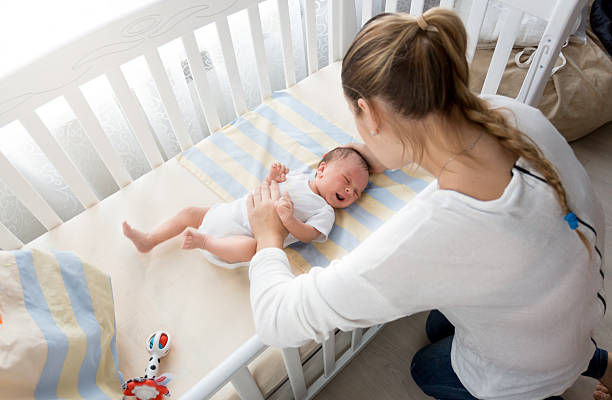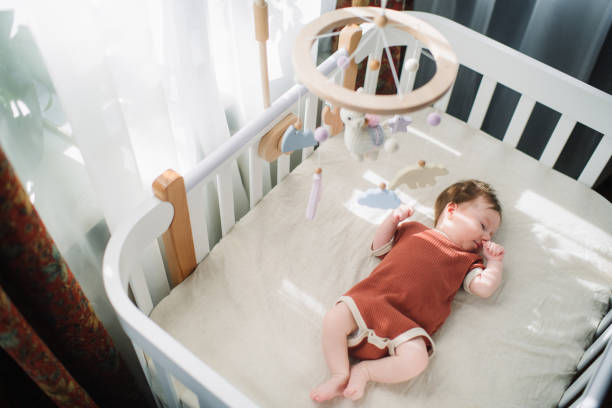Every parent’s dream is to have a sleeping baby, but most new parents’ worst nightmare is to have a baby who won’t sleep in their bassinet! What should you do if your infant won’t go to sleep in their bassinet? A fussy baby and restless nights lead to an unhappy home.
Why Won’t My Baby Sleep in a Bassinet?
Your Baby is Used to Sleeping in Your Arms.
We are all aware of how challenging it is to put down a soft, adorable newborn. Furthermore, holding a sleeping baby is a universal love. Babies who frequently sleep while being held, however, may have trouble dozing off without that comfort.
You should try to stay away from this if at all possible. It can be very challenging to get your baby to fall asleep unattended once habits have been formed.
This is why it’s crucial for your baby to spend the daytime sleeping in their bassinet in order to develop good sleep habits. Try to place your infant in their bassinet for naps during the day. Your baby will start to feel at ease in their bassinet if you allow them to do so frequently.
Your Baby is Uncomfortable.
Your infant might find the bassinet uncomfortable and decide not to sleep there. A sleeping baby will be awakened by a soiled diaper, a hard mattress, or a scratchy swaddle or receiving blanket.
Check your baby’s diaper and bassinet for any irritation if you notice that they wake up soon after you put them to sleep. Check your newborn’s fingers and toes as well because long hairs have a tendency to get tangled in these small spaces. The circulation to that area of your baby’s body may be cut off if these hairs are ignored.
Your Baby is Overstimulated.
It’s not unusual for newborns to become overstimulated right before bed. Your baby may struggle to fall asleep if there has been excessive activity or stimulation right before bed. Babies who are overtired will be excessively fussy and awake for extended periods of time.
The most popular sleep solution is creating a bedtime routine. Normal patterns and routines are usually necessary for a newborn baby who is overtired. These routines help your baby sleep soundly by serving as a cue that bedtime is approaching.
Your Baby is Sick.
It may be due to illness if your infant has only recently refused to sleep in the bassinet. Look for other symptoms of illness, such as a cough or stuffy nose. Numerous newborns also experience gas and tummy issues, which can keep them up at night.
If this is the case, put your newborn to sleep by easing their discomfort or assisting with breathing. Hold your child upright in a steamy bathroom to relieve congestion.
Your Baby’s Startle Reflex is Waking Them.
One of the hardest challenges to peaceful sleep may be a baby’s startle reflex. Despite all of your efforts, if your infant only sleeps for brief intervals, this may be the cause of why they won’t go to sleep.
The Moro reflex is another name for this reaction. This explains why your child might have jumped or moved while they were sleeping. By the time they are six months old, infants usually outgrow this.

7 Tips to Get Your Baby to Sleep in a Bassinet
Work on the First Nap of the Day in the Bassinet.
Typically, it is the simplest nap to get a baby to take. To make it happen, utilize the pickup and put-down technique. Offer them comfort by putting them down and by giving a reassuring word. Allow your baby to settle for two to three minutes; if they start to become agitated, pick them up and soothe them before trying again.
Establish a Bedtime Routine
Setting up a bedtime routine is one of the best ways to get your baby to sleep in a bassinet. Here are some helpful things to include in a bedtime routine:
- Bath
- Singing lullabies
- Reading a book
- Baby Massage
- Calming essential oils
It’s crucial to stick to your routine, even if it’s scaled back on nights when you’re short on time. Spending a few extra minutes to make sure your baby is peaceful and prepared for sleep is worthwhile.
Make Sure Your Baby’s Sleeping Area is Comfortable
A content baby is a happy baby. When getting your little one to sleep in a bassinet, you want to make sure they’re as comfortable as possible. Making their bassinet a comfortable sleeping area is a big part of that.
Here are a few tips to help you create a comfortable bedtime environment for your baby:
- Use a snug-fitting, firm bassinet mattress. Your baby’s developing spine will benefit from this support.
- To keep your baby from becoming overheated or perspiring, dress them in lightweight, breathable clothing.
- Prevent suffocation risks by keeping the bassinet clear of pillows and stuffed animals.
- To give your baby more warmth and comfort, keep a few plush blankets on hand to swaddle them in. Consequently, your baby will sleep with fewer jerky movements.
Avoid Overstimulation before Bedtime
Babies who are overstimulated are frequently fussy and difficult to calm. Even though they are tired, an overstimulated baby won’t fall asleep. Additionally, they might experience disturbed sleep patterns and nighttime awakenings.
If your baby displays signs of being overtired and won’t go to sleep at night, make sure you’re teaching him or her healthy sleeping habits during the day. A newborn who snoozes more during the day will probably sleep more at night. Similarly, a baby who is overtired and skips naps is likely to wake up frequently at night.
Overstimulated babies can be avoided by turning down the overhead lights and avoiding stimulation from computer or television screens. A half-hour prior to your baby’s bedtime, try turning off the electronics and dimming the lights.
Swaddle Your Baby
Swaddling your baby might work if they won’t sleep in their bassinet. They’ll be able to relax, get to sleep easily, and have fewer startle reactions as a result. Swaddle blankets give newborns a womb-like feeling of comfort, which aids in their ability to fall asleep.
Use a large receiving blanket or a specific swaddle wrap to swaddle your infant. Their arms shouldn’t jerk, so the swaddle should be just snug enough. But it shouldn’t be so tight that you can’t fit two fingers under the top of the swaddle.
Lay Them Down Awake
Many parents find it relaxing to rock or nurse their infants to sleep. However, occasionally, this leads to behaviors that prevent self-soothing. When rocking or nursing your baby, try to avoid letting them fall asleep. Instead, place them in their bassinet while they are still awake and sleepy.
A sound sleep pattern will develop if you let your infant fall asleep on their own. You can get support for this process from a variety of sleep training techniques.
Move the Bassinet a Few Feet Away from Your Bed.
It can occasionally be difficult for you both to fall asleep with them so close by. Then relocate it a few feet.

Why is It Important That Babies Sleep in a Bassinet?
It’s Safer for Your Baby.
Babies need to sleep in their bassinet so that they have a secure place to do so. The safe sleep recommendations from CDC recommend that infants sleep in a bassinet or crib rather than in the same bed as their parents. This advice is supported by data that indicates babies who share a bed with their parents have a higher risk of SIDS.
It Helps Your Baby to Establish Healthy Sleep Habits.
Babies who fall asleep while being held by their parents may grow to depend on holding to stay asleep. Your baby will learn to associate their bassinet with sleep if they use it for both daytime and nighttime naps.
This association will make it easier for your baby to doze off at night. Your baby will benefit from learning how to comfort themselves and go back to sleep on their own if they wake up during the night. Self-settling is a crucial skill for better sleep.
Long Game.
We frequently promote sleeping in arms because we are so in love with our precious little one and don’t really know what we’re doing when it comes to your newborn’s sleep. However, you should consider the big picture when it comes to baby sleep. Where do you want your infant to sleep when she is 8 months old? She will eventually need to be restrained in a secure setting. This entails introducing that environment at this stage of habit and preference formation.
Safety Rules for Using Bassinets
- Your baby’s crib or bassinet needs to have a firm mattress and be clear of any extra blankets, toys, or pillows. (Ensure that the swaddle is not covering your baby’s head. Swaddles should begin just below the shoulders.)
- The crib should be set up so that your baby can sleep on their back.
- Never use a sleep positioner. (The use of sleep positioners, according to studies, can increase the risk of suffocation.)
- Do not share your bed with your infant. Keep them in their crib or bassinet all night long.
Conclusion
If your baby is younger than 8 weeks old, you should be keeping track of her behavior and taking notes to see if reflux or gas might be the cause of her discomfort. She may notice your comfort more than the typical child. If not, you still have time to work on getting your baby to fall asleep in the bassinet and introducing this new sleeping arrangement. For babies 4 months and older, if she will only sleep on you, you will likely have to do some “sleep teaching” to teach your baby that sleep can happen in a different way and work on undoing learned behavior.
